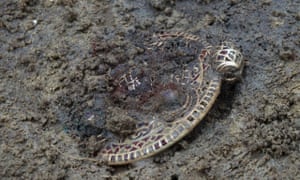via the OUP blog by William Whyte

All Saints Church Margaret Street, London by Diliff. CC BY-SA 3.0 via Wikimedia Commons
With hundreds of churches built, rebuilt, or restored in the nineteenth century, they can be found nearly everywhere today. Out of thousands of possible choices, below are five characteristic specimens — four small churches and one large synagogue — that explain Victorian belief.Continue reading
==============================
via the Guardian by Maev Kennedy

A gold and garnet pendant discovered in Winfarthing, a site with no record of any Anglo-Saxon settlement. Photograph: British Museum
A glorious jewel made from hundreds of tiny pieces of garnet set in gold to form geometric and animal shapes lay for 1,400 years on the breast of an unknown woman until her Norfolk grave was rediscovered by a first-year university student. The item was among a record number of treasure finds reported by the British Museum in the year 2016.
The pendant and other jewels and coins buried with the woman were among the spectacular discoveries mainly made by metal detectorists – including a hoard of 158 bronze age axes and ingots, the largest of its kind to be found in Yorkshire; and more than 2,000 silver Roman coins in Piddletrenthide, Dorset, which the finder and a local archaeologist managed to lift together with the clay pot holding them and the entire block of soil in which it was buried, so it could be studied at the British Museum.
Continue reading
==============================
via Interesting Literature
Interesting William Gibson facts
1. William Gibson popularised the term ‘cyberspace’ in a short story of 1982. Defined as ‘the notional environment in which communication over computer networks occurs’, cyberspace first appeared in fiction in William Gibson’s 1982 story ‘Burning Chrome’ (no relation to Google Chrome, we’re told), a story about a couple of freelance hackers. (Before it was published, Gibson read this story out at a science fiction convention – to an audience of four people.) But contrary to a widely held belief, William Gibson did not actually coin the term: it had originated, surprisingly, back in the 1960s when two Danish artists styled themselves as Atelier Cyberspace, after ‘cybernetics’, a term invented by Norbert Wiener way back in 1948 in his book Cybernetics: Or Control and Communication in the Animal and the Machine. (‘Cybernetics’, by the way, comes from the Greek meaning ‘steersman’ or ‘pilot’.) Gibson, however, helped to bring the term ‘cyberspace’ to a much wider audience, especially after the success of his smash-hit cyberpunk novel, Neuromancer, in that uncannily dystopian year, 1984.
Continue reading
==============================
via Boing Boing by Mark Frauenfelder
==============================
via An Awfully Big Blog Adventure by Lu Hersey

Here’s a true story. I wrote a weather charm into my debut novel, Deep Water. It consisted of three intricate knots, tied in a piece of rag. Each time my protagonist untied a knot, it unleashed stronger weather, until she undid the third, when all hell let loose. I got the idea from the sign at the Museum of Witchcraft in Boscastle, where it’s said that ‘selling the wind’ to fishermen was once a common practice on the quayside. But I had no idea what their weather charms looked like. They could have been Cornish piskies for all I knew, so I made mine up – or at least I thought I did.
Continue reading
==============================
via the Big Think blog by Stephen Johnson

Jurassic Park
Why have so many modern-day mammals evolved adaptations suited for the night? The answer might very well be dinosaurs, according to new research.
A study published in the journal Nature Ecology & Evolution suggests that the threat of dinosaurs, who ruled the world during the daytime more than 65 million years ago, encouraged mammals to only come out under the dark of night.
This idea – known as the “nocturnal bottleneck hypothesis” – has intrigued scientists for years, but it’s been difficult to prove by direct means. The new study explores the hypothesis further by analyzing the behavior patterns of 2,415 mammal species, and then using computer models to predict the behavior of their ancestors.
Continue reading
==============================
via the Guardian by Press Association

National Geographic’s January 1965 issue included a photograph entitled Mountain Madonna. ‘She looked very proud,’ says McCartney. Photograph: Howard Sochurek/National Geographic/PA
Sir Paul McCartney has spoken of his inspiration for the Beatles song Lady Madonna: a photograph of a woman breastfeeding her child in National Geographic.
McCartney said he was inspired to write the song, which reached the top of the charts in 1968, after seeing then image in the magazine in the 1960s.
National Geographic’s January 1965 issue included a photograph entitled Mountain Madonna, of a woman whose way of life was threatened, with one child at her breast and another laughing up at her.
“She looked very proud and she had a baby ... And I saw that as a kind of Madonna thing, mother and child,” McCartney said.
“Sometimes you see pictures of mothers and you go: ‘she’s a good mother’. You could just tell there’s a bond and it just affected me, that photo. So I was inspired to write Lady Madonna, my song, from that photo.”
Continue reading
==============================
via Interesting Literature
A commentary on Shakespeare’s 87th sonnet
‘Farewell! thou art too dear for my possessing’. Nobody could accuse Sonnet 87 of failing to begin dramatically. One of the more famous sonnets in Shakespeare’s sequence of 154 poems about love, sex, desire, wigs (see Sonnet 68), and rivalry, Sonnet 87 is also one of the great English poems about deciding to end a relationship. (Indeed, it could have featured, although it didn’t, in our pick of the greatest breaking-up poems.) Before we proceed to our analysis of the poem’s meaning, here’s a quick reminder of Sonnet 87.
Continue reading
==============================
via Boing Boing by Andrea James

Acorn woodpeckers create acorn granaries that hold tens of thousands of acorns. Scientists are especially interested in their living arrangements, once described by Cold War ornithologists as communism.
Continue reading (and watching)
No comments:
Post a Comment